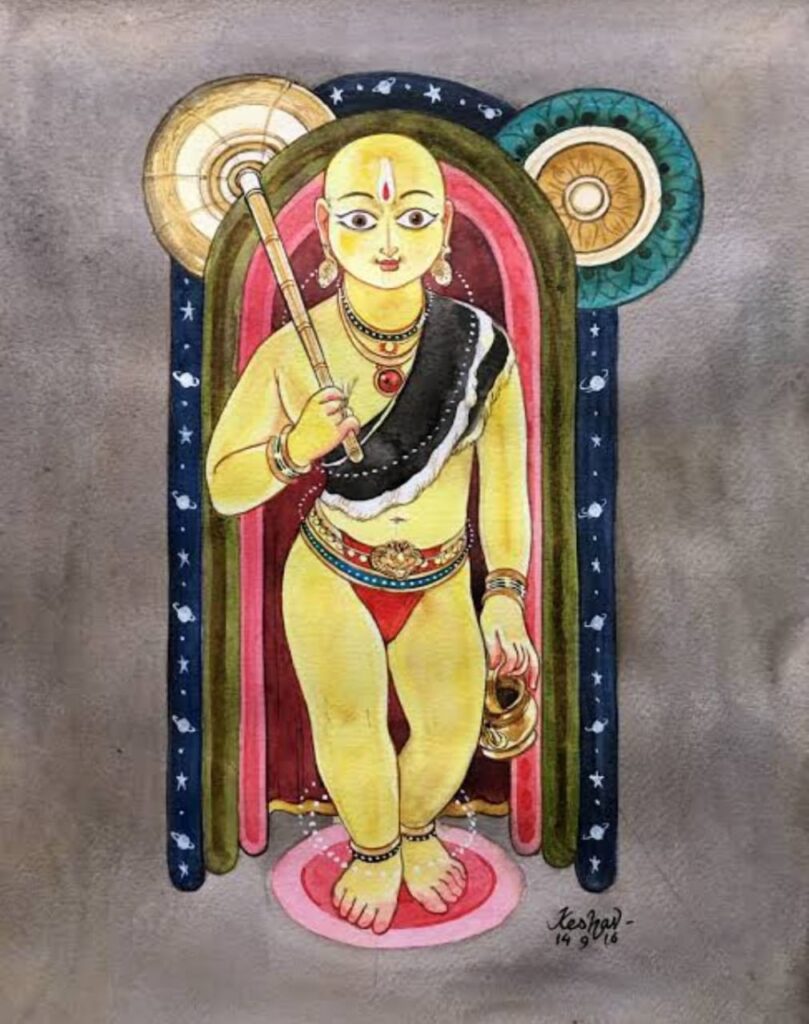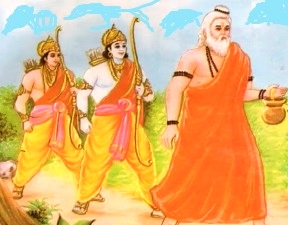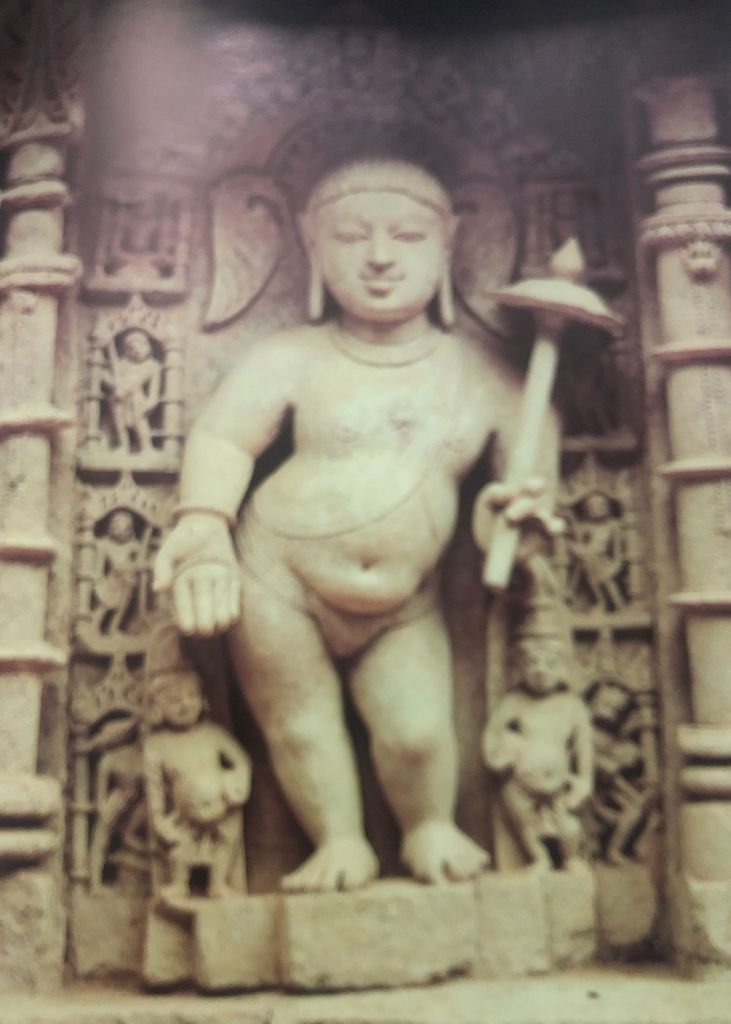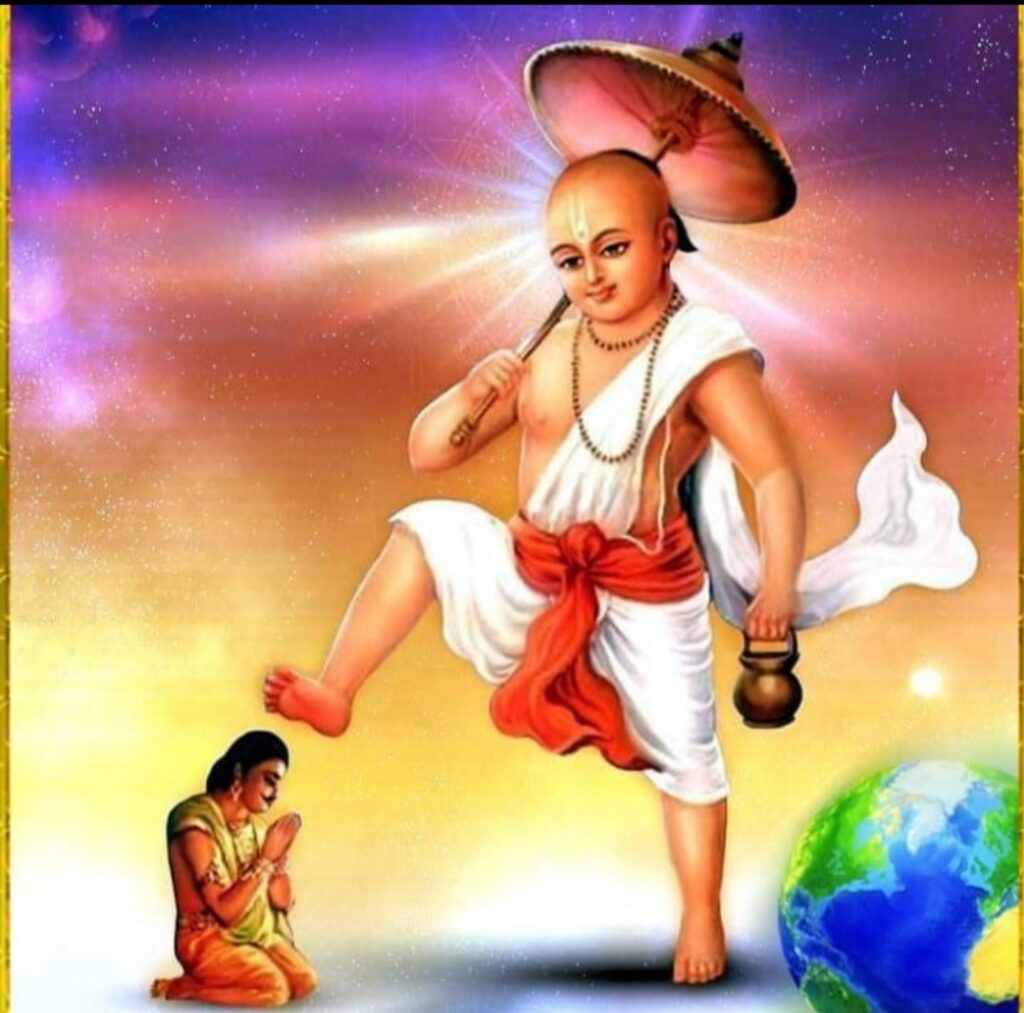
The origins of the myth of Vamana incarnation of Lord Vishnu lie in several Rchas of the RgVeda where Vishnu has been equated with the Sun traversing the three realms of the Earth, the sky and the intervening celestial space and dispelling the darkness through the course of his celestial journey. For example, two verses from the Book I hymn 22 are given (Translation by Ralph T.H. Griffith, 1896) here:
(17) इदं विष्णुर्वि चक्रमे त्रेधा नि दधे पदम्। समूळ्हमस्य् पांसुरे।। Through all this world strode Vishnu; thrice his foot he planted, and the whole was gathered in his footstep’s dust.
(18) त्रीणि पदा वि चक्रमे विष्णुर्गोपा अदाभ्यः। अतो धर्माणि धारयन्।। Vishnu, the Guardian, he whom none deceives, made three steps; thenceforth establishing his high decrees.
The Shatapatha Brahmana mentions how the Devas, after a disastrous defeat at the hands of Asuras, approachedLord Vishnu, who assumed a dwarf form and pleaded the Asuras to restore them a piece of land measuring his three steps only. As the Asuras seemed to agree, Vishnu assumed the extra-large form, spanning across the three worlds, and reoccupied the Three Worlds.
The myth has evolved further in the two Great Epics and the various Puranas. The crux of these later myths is that Vishnu made his fifth descent on Earth as Vamana, the short-statured son of Sage Kashyapa and his spouse Aditi, to prevent Bali, the King of Asuras, from obtaining dominion of the three worlds. Lord Vamana impressed Bali as the child prodigy and secured a donation of a piece of land measuring his three steps. Afterwards, the Vamana assumed his Virata (gigantic) form and covered the entire expanse of Earth and the Heaven with his two steps. King Bali was banished to the Sutala Loka (roughly translated as the Continental Shelf) for failure to fulfil his bond obligation.
The Ramayana (Book I Chapter 29) narrates the myth of the Vamana incarnation taking place at the Siddhashrama, a place located in Buxar in Bihar. Sage Vishvamitra, who had his hermitage at that place, told this myth to Rama and Laxmana, as they accompanied him from Ayodhya to his Siddhashrama for fighting the menace of demons. An English translation of the passage by Hari Prasad Shastri; SHANTI SADAN,29 Chepstow Villas,LONDON (1952) is as under:
“O Rama, this is the place at which the Blessed Lord Vishnu, the first among the gods, dwelt, observing his yogic practices for immeasurable years and previous to that, it belonged to the glorious Vamana. This spot is called Siddha-ashrama, for here, these great souls practised austerities with success. At that time, Bali the son of King Virochana, conquered Indra and other devas, together with the deities of the wind and he ruled over the three worlds. When Bali initiated a sacrifice, the devas, under the leadership of Agni approached Shri Vishnu in this hermitage and said: O Lord, the son of Virochana, King Bali is observing a great sacrifice ; while it is yet incomplete, come to our aid. The Lord grants the requests of those who seek His favour, therefore, by the power of your Yoga and for our own good, take the form of a dwarf (Vamana) and secure our welfare. Meantime, O Rama, the Sage Kashyapa, resplendent as fire, who was endowed with supreme lusture by virtue of his yogic practices, with his spouse Aditi, having completed a thousand years’ austerities, began to praise Madhusudana, the conferrer of boons, saying: ‘ O Supreme Purusha, You are adored through austerity and You do grant the fruit of austerity, Your nature is knowledge and asceticism, it is by virtue of austerity that I behold you. O Lord, in your body I see the whole world animate and inanimate. In you, who are without a beginning and indescribable, I take refuge.’ The blessed Vishnu was pleased with this prayer and said to the sinless Sage: ‘ O Kashyapa, may you see perfection, you have merited a boon, ask what you desire.’

Then Kashyapa, the son of Marichi, answered: O Blessed Lord, Aditi, the gods and I beseech you to grant this boon — Become the son of my sinless wife and myself. O Lord, become the younger brother of Indra and assist the sorrow- stricken devas. This spot, by your grace, shall then be known as Siddha-Ashrama.’ (सिद्धाश्रम=Hermitage of the Perfect Ones.) Upon this, the resplendent Vishnu was born of the womb of Aditi as the incarnation Vamana and disguised as a mendicant, he approached King Bali. Of him, he requested a piece of ground that could be covered by three strides, and having obtained what he asked, he covered the whole universe in three steps. This restful hermitage formerly belonging to Vamana, whose devotee I am, is enjoyed by me. Here the rakshasas wreak destruction. O Lion among men, remain here and slay them. O Rama, today let us enter the Siddha-Ashrama together. O Friend, this hermitage is not only mine but thine also.”

The Bhagavata Purana Book VIII. Chapters 18-23 gives an account of Vamana incarnation taking place at Bhṛgukaccha, that is, the modern day Bharuch in Gujarat. The legend (based on the translation by Srila Prabhupada) is as under:
Lord Vamana appeared in this world from the womb of Aditi completely equipped with conch, disc, club and lotus. His bodily hue was blackish and he was dressed in yellow garments. Lord Vishnu appeared at an auspicious moment on Shravaṇa dvadashi when the Abhijita star had arisen. Wearing a belt made of munja straw, an upper garment of deerskin and a sacred thread and carrying in his hands a staff (danda), an umbrella and a waterpot ( Kamandalu), Lord Vamana appeared in the sacrificial arena of Maharaja (Emperor) Bali on the northern side of the River Narmada, at the field known as Bhrgukaccha . Lord Vamana asked for three paces of land in charity; King Bali agreed to his proposal, despite being warned by his priest Shukracharya. Knowing well that Lord Vamana was cheating him, King Bali gave everything to the Lord in charity, while the Lord Vamana extended his body and assumed a gigantic form that covered the entire surface of the world, and with the first step the entire sky. With his hands he covered all directions, and with his second footstep he covered the entire upper planetary system. Therefore, there was no vacant place where he could take His third footstep. Lord Vishnu, desiring to advertise the glories of king Bali, arrested him for not fulfilling his promise in regard to the Lord’s third step. However, pleased by the determination and integrity of Bali, the Lord placed him on the planet called Sutala, and there, after bestowing benedictions upon him, the Lord agreed to become his doorman.

The Vamana Purana is principally dedicated to the Vamana incarnation; it narrates the same story, however, with little variations. The place of incarnation of Vamana is indicated as ‘ Kashyapa Ashrama in the Aditi Vana’ in the Kurukshetra in Haryana: प्रयाताः प्राग्दिशं सर्वे विपुलं कश्यपाश्रमम्। ते कश्यपाश्रमं गत्वा कुरुक्षेत्रवनं महत्।। ( Vamana Purana Ch.27.12). Further, the place of sacrifice by Bali is also mentioned as Kurukshetra only. गते Sथ तीर्थयात्रायाम् प्रह्लादे दानवेश्वरे। कुरुक्षेत्रंम समभ्यागाद् यष्टुं वैरोचनो बलिः।।( Vamana Purana Ch.88.1).The varying accounts of different texts in respect of the places of incarnation of Lord Vamana and his pastime go on to suggest that the myth of Vamana is pan-Indian in popularity. In fact in the Chapter 89 of the Vamana Purana a list of many places, all across the length and breadth of Indian sub-continent, from Kailash (Tibet) in the north to Sinhal Dveep (Srilanka) in the South and Saindhava-Aranya (Sindh) in the West to Kamarup (Assam) in the East, has been given where the abodes of Vamana and Vishnu are located.
The myth of Vamana has evolved from his most ancient form as the magnificent Sun dispelling the mighty darkness to his incarnation as the dwarf , who did not hesitate even in deceitful execution of his policy of protecting the interests of the Devas. As such this avatara (incarnation) reminds one of the witty remark by a 17th century ambassador of the king of England, who said ” An ambassador is an honest man sent to lie abroad for his country.” Lord Vamana, as tha ambassador of Devas, also did his job-‘mentir et demantir’: to lie and deny! Jayadeva, the composer of Gita Govinda penned down :
छलयसि विक्रमणे बलिमद्भुतवामन। पदनखनीरजनितजनपावन।। केशव धृतवामनरूप जय जगदीश हरे।।O Kesava (Vishnu) ! In the form of the Dwarf (Vamana) You cleverly deceived the King of the world, Bali. Cleanser of the people through the sweat of your toenails. Praise be to Jagadish!Lord of the universe !

kesava dhrta vamanarupa; jaya jagadisa hare!”
